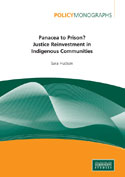
High Indigenous incarceration rates have elicited a long list of so-called solutions over the years. Since the 1991 Royal Commission into Aboriginal Deaths in Custody (RCIADIC), countless reports and programs have aimed to reduce the Indigenous incarceration rate. Yet the percentage of Aboriginal people in custody has continued to rise, nearly doubling from 14% of the prison population in 1991 to 27% in 2012.
The latest ‘solution’ to high Indigenous incarceration, and the focus of this monograph, is Justice Reinvestment. Justice Reinvestment is a school of thought from the United States that proposes redirecting money spent on prisons into programs that address the underlying causes of offending in communities with high levels of incarceration.
Justice Reinvestment involves three steps:
- gathering data on offending and the criminal justice system
- using the data to create justice maps (areas with the greatest concentration of offenders)
- redirecting funds from corrective services to implement programs in ‘targeted’ locations to reduce offending and evaluating the effectiveness of the programs.
The underlying premise of Justice Reinvestment—to build communities rather than prisons—has proven seductive, and many countries are now applying or investigating Justice Reinvestment.
Australia is the latest country to consider adopting Justice Reinvestment. The Australian Senate is conducting an inquiry into the value of a Justice Reinvestment approach to criminal justice in Australia, with a particular focus on the over-representation of Aboriginal and Torres Strait Islanders in Australia’s prisons.
Advocates of Justice Reinvestment in Australia have been quick to highlight the success stories from overseas but a number of important differences exist between the criminal justice systems in the United States, the United Kingdom, and Australia. These disparities suggest that the application of Justice Reinvestment strategies in Australia could be difficult, and that Australia needs to exercise caution and not embrace Justice Reinvestment just because everyone else is.
In the United States, three-quarters of offenders are given custodial (prison) sentences, whereas only one-fifth of the sentences imposed in Australia are custodial, which means, the United States has more room to ‘manoeuvre’ because it has more offenders to keep out of prison compared to Australia.
A key feature of Justice Reinvestment in the United States is the devolution of power from state to local authorities. But in Australia, criminal justice is already the responsibility of state and territory governments, and it is highly unlikely that this responsibility will be devolved to local government authorities.
Advocates of Justice Reinvestment claim it saves money, but in all the states in the United States where Justice Reinvestment strategies have been applied, prisons may have closed but correctional service budgets have continued to grow. In the United Kingdom, Justice Reinvestment approaches seem to be accompanied by a parallel rise in the prison population.
Justice Reinvestment appears to recycle familiar old ‘preventive’ and community-based programs in a new wrapping. The localised, community-focused approach characteristic of Justice Reinvestment is already a feature of Aboriginal Community Justice Groups in NSW, Queensland and the Northern Territory. Justice Reinvestment supporters have yet to explain how the approach will be any different or an improvement on existing community-based justice programs.
Following the 1991 RCIADIC, crime ‘prevention’ polices have applied ‘culturally appropriate’ or ‘culturally secure’ approaches to reduce Indigenous incarceration. For example, initiatives such as Circle Sentencing and the Koori and Murri courts, where Aboriginal offenders are brought before their community elders for sanctioning, were established. Yet such initiatives have merely ‘tinkered’ with aspects of the criminal justice system and not addressed the underlying reasons why people are offending.
In the fight against Indigenous disadvantage and incarceration, Justice Reinvestment threatens to become a distraction from focusing on the fundamentals such as education and employment that will lead to change. Zero employment among 35% of the Aboriginal population plays a critical role in the high rates of Indigenous incarceration, with unemployed Indigenous people 20 times more likely to be imprisoned than employed Indigenous people. In fact, unemployment has been found to be a greater risk factor for offending than Indigenous status.
Education and employment may not sound as novel or exciting as Justice Reinvestment, but evidence shows they play a critical role in the high Indigenous incarceration rate. Improving educational outcomes should not be reliant on the diversion of funds from prison services but a basic right that states and territories should be covering in their education budgets.
Sara Hudson is a Research Fellow in the Indigenous Affairs Research Program at The Centre for Independent Studies (CIS). Her research focuses on issues affecting Indigenous Australians, including the Community Development Employment Projects (CDEP) program, Indigenous homeownership, lack of accountability in Indigenous health, remote Indigenous stores, alcohol restrictions, and training for Aboriginal health workers.










